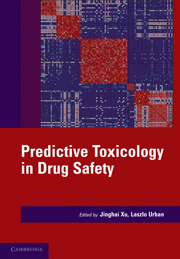Book contents
- Frontmatter
- Contents
- Contributors
- Prologue – Predictive toxicology: a new chapter in drug safety evaluation
- PREDICTIVE TOXICOLOGY IN DRUG SAFETY
- I SPECIFIC AREAS OF PREDICTIVE TOXICOLOGY
- 1 The human predictive value of combined animal toxicity testing: current state and emerging approaches
- 2 Screening approaches for genetic toxicity
- 3 Cardiac safety
- 4 Predicting drug-induced liver injury: safer patients or safer drugs?
- 5 In vitro evaluation of metabolic drug–drug interactions
- 6 Reliability of reactive metabolite and covalent binding assessments in prediction of idiosyncratic drug toxicity
- 7 Immunotoxicity: technologies for predicting immune stimulation, a focus on nucleic acids and haptens
- 8 Predictive models for neurotoxicity assessment
- 9 De-risking developmental toxicity-mediated drug attrition in the pharmaceutical industry
- II INTEGRATED APPROACHES OF PREDICTIVE TOXICOLOGY
- Epilogue
- Index
- Plate section
- References
3 - Cardiac safety
from I - SPECIFIC AREAS OF PREDICTIVE TOXICOLOGY
Published online by Cambridge University Press: 06 December 2010
- Frontmatter
- Contents
- Contributors
- Prologue – Predictive toxicology: a new chapter in drug safety evaluation
- PREDICTIVE TOXICOLOGY IN DRUG SAFETY
- I SPECIFIC AREAS OF PREDICTIVE TOXICOLOGY
- 1 The human predictive value of combined animal toxicity testing: current state and emerging approaches
- 2 Screening approaches for genetic toxicity
- 3 Cardiac safety
- 4 Predicting drug-induced liver injury: safer patients or safer drugs?
- 5 In vitro evaluation of metabolic drug–drug interactions
- 6 Reliability of reactive metabolite and covalent binding assessments in prediction of idiosyncratic drug toxicity
- 7 Immunotoxicity: technologies for predicting immune stimulation, a focus on nucleic acids and haptens
- 8 Predictive models for neurotoxicity assessment
- 9 De-risking developmental toxicity-mediated drug attrition in the pharmaceutical industry
- II INTEGRATED APPROACHES OF PREDICTIVE TOXICOLOGY
- Epilogue
- Index
- Plate section
- References
Summary
INTRODUCTION: THE STATUS OF THE PROBLEM
Over the last two decades, several medicines were withdrawn from the market because their use in patients has been discovered to be associated with the development of a very specific potentially life-threatening polymorphic ventricular tachycardia, Torsade de pointes (TdP). In approximately 20 percent of the cases, TdP can develop into ventricular fibrillation and lead to sudden death. The recently finalized ICH S7B guideline defines the prolongation of the QT interval (measure of time between Q and T waves in the electrocardiogram) on the surface electrocardiogram as an appropriate biomarker for predicting the torsadogenic risk of a given compound. However, a growing body of evidence suggests that the QT interval prolongation is an incomplete biomarker of a drug's torsadogenic potential. The generation of TdP is triggered more by dynamic combination of multiple predisposing factors and components and favored by myocardial substrate rather than by a single electrophysiological event. Following recommendations of the respective guideline, the pharmaceutical industry has intensively implemented methodologies to assess the potential risk of QT prolongation and TdP in man. The key task of each cardiac safety testing strategy requires a case-by-case analysis; how to find the best combination of different test capabilities considering their strengths and limitations to detect the liability of a chemical structure to induce lethal arrhythmia of very low clinical incidence. This chapter will provide a brief overview on the current methodologies and considerations that are useful in predicting QT prolongation in man and/or a torsadogenic liability.
- Type
- Chapter
- Information
- Predictive Toxicology in Drug Safety , pp. 34 - 53Publisher: Cambridge University PressPrint publication year: 2010
References
- 1
- Cited by



